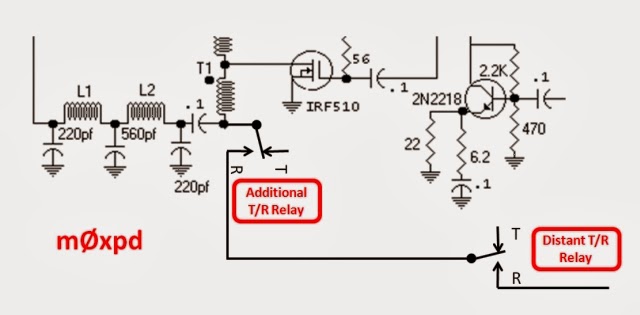This is a small, single-band CW rig - recently made available in the UK as a kit by Kanga.
The rig uses an ATmega micro-controller and a Programmable System-on-Chip (PSoC) to supervise operation of an otherwise traditional, analog transceiver. The transceiver boasts a superhet receiver and uses a single mixer to combine the transmit BFO and VFO signals, producing (in my build) 7.1 Watts of RF into the usual 50 Ohm load.
The digital components support a frequency display, a capable and comprehensive keyer and a morse decoder. This balance of digital features might be enough to give a clue that the rig has its origins with Steve, k1el, of Winkeyer fame.
There is a web page and a Yahoo group providing support for the design and the hardware details are available on the net (e.g. at the Kanga website). The code, however, is not openly available - a copy is given to all kit purchasers.
The Kanga kit is supremely well presented, with all the components packed into small zip-lock bags corresponding to the carefully designed step-by-step build sequence. This makes the assembly of what is a quite complicated and densely packed PCB very simple - as close as you can reasonably get to "painting by numbers". Furthermore, the staged assembly process is reflected in the layout of the board, seeing the builder start assembling sub-systems located in the middle of the board before going on to work on the periphery.
Here's the board at a fairly early stage of assembly (just after completing the VFO)...
I fell foul of what I believe to be an error in the kit; if you assemble the LCD display board according to the instructions, the LCD will not lie parallel to the font of the case (normal to the main PCB)...
On careful inspection, I realised that it is possible to fit the 90 degree header pins to the LCD according to (what turns out to be) an incorrect alignment, as seen in the sketch below at (A). It is important that there is clearance (c) between the plane of the pins and the surface of the LCD board (as at (B)) if the LDC is to fit.
On reaching page 24 of the build instructions, "Checkout of the Transmit Mixer", I was advised that I should have between 200 and 250mV pk - pk at U1 of the Transmit (SA612) mixer. Measuring it, I found only 115 mV. I was worried that this would cost me some transmit power, so I lifted up the VFO injection level by adding another 10pF in parallel with C16...
This gave me 220 mV at U1, pin 1 - in line with expectations from the instructions.
On completing my build of the rig, I've not been entirely happy with the stability of the VFO (of which more in a later post). However - my slight modification of the circuitry near the VFO has made people reluctant to accept that I had not brought my VFO into disrepute by my own actions! So - this morning, I removed the additional capacitor.
I'm back to 115 mV on U1, pin 1, BUT I STILL GET 7.1W output.
Hmmm.
Here's the completed board...
It took me a day and a couple of hours of last weekend to go from a box of bits (in carefully sorted little bags) to a rig which let me have a QSO with f5ijy, op Phil, nr Dijon for 579 to 589. Phil said the rig was "doing a fine job" - so we'll take his word for it!
In summary...
This is a nicely designed transceiver, which has been very well presented as a kit. It is easy to build and results in an easy-to-use rig with some nice integral features (particularly the keyer).
Looking for a moment at some of the demerits, I would prefer a straight key input AND paddle input (which I fit as "standard" to all my rigs). I think that the Open QRP rig is unusual in using analog RF generation (going against the contemporary flow of the TenTec Rebel, Farhan's Minima and - not least - my offerings). You should not be fooled by the CW reader - which works well on strong signals, but which will not buy you out of the requirement to learn to read CW yourself! Most importantly, I don't think that this is truly an "Open" project (with the limitations on code distribution and the use of a proprietary PSoC).
In use, I retain some concerns about the VFO which, to date, has made the rig difficult to use in the ten minutes after turn-on. However, this is a very good way of getting onto 40m for what seems to me to be a very reasonable price.
...-.- de m0xpd

























